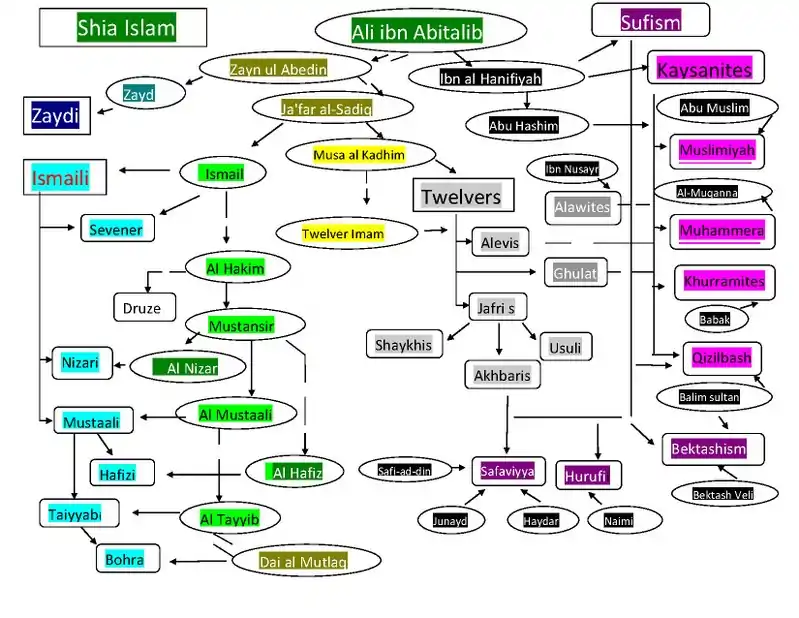Muhammad ibn al-Hanafiyyah
Muhammad ibn Ali ibn Abi Talib (Arabic: محمد بن علي بن أبي طالب) also known as Muhammad ibn al-Hanafiyyah (Arabic: محمد بن الحنفية) (15 AH – 81 AH; c. AD 637 – 700) and surnamed Abu'l-Qasim. He was the third son of Ali ibn Abi Talib, the first Imam of Shi'a Muslims and the fourth Caliph of Sunni Muslims.
Muhammad ibn al-Hanafiyyah ibn Ali | |
|---|---|
 Name of Muhammad ibn al-Hanafiyyah in the style of Arabic calligraphy | |
| Personal | |
| Born | 15 A.H/AD 637 (2nd year of the Caliphate of Umar ibn Khattab) |
| Died | Wednesday, 1st Muharram, 81 A.H/ 25 Feb, AD 700 |
| Resting place | Medina, Saudi Arabia |
| Religion | Islam |
| Parents |
|
| Lineage | Hashemite , Hashmi |
| Muslim leader | |
| Period in office | 681–700 |
| Predecessor | Hussein ibn Ali |
| Successor | Abu Hashim |
Biography
Muhammad ibn al-Hanafiyyah (Muhammad Akbar) was born in Medina about AD 633 (though also said to be during Umar's era), the third of Ali's sons. He was called Ibn al-Hanafiyyah after his mother, Khawlah bint Ja'far; she was known as Hanafiyyah, "the Hanafi woman", after her tribe Banu Hanifah. After the death of Muhammad, the people of Yamamah were declared apostates by the Muslims for refusing to pay the zakat (religious tax); the men were killed (see Ridda wars), and the women were taken to Medina as slaves, Khawlah bint Ja'far among them. When her tribesmen found out, they approached Ali ibn Abi Talib and asked him to save her from slavery and to protect her family's honor and prestige. Consequently, Ali ibn Abi Talib purchased her, set her free, and, after the passing away of Fatimah, married her.[1] Muhammad ibn al-Hanafiyyah was the only child of Khawlah bint Ja'far. During his father's lifetime he distinguished himself for piety, rectitude, and courage and effectiveness in war. During Ali's caliphate at Kufa he was one of the caliph's four chief lieutenants. He particularly distinguished himself at the battles of Jamal and Siffin.[2] During the Battle of Siffin, Ali described ibn al-Hanafiyyah as his hand due to his bravery and strength while fighting.[3]
When Husayn, then in Mecca, was considering the expedition to Kufa that ended at Karbala, Muhammad ibn al-Hanafiyyah advised him not to go,[4] pointing out that the men of Kufa had betrayed and turned against their father Ali[5] and their brother Hasan ibn Ali,[6] and saying that he feared that they would betray Husayn as well. Husayn replied that he feared that if he stayed in Mecca, Yazid ibn Muawiya would have him killed there, and violate the sanctity of the Holy City. Muhammad ibn al-Hanafiyyah then urged him to go instead to Yemen, where he could indefinitely elude an army. The next day Husayn replied that his grandfather Muhammad had appeared to him in a dream and required him to undertake this sacrificial expedition.[4]
After Husayn and so many of his kinsmen died at Karbala and the young Ali ibn Husayn adopted a life of retirement and prayer, Muhammad ibn al-Hanafiyyah became the visible head of the house of Ali (see Kaysanites Shia). It was in his name that Al-Mukhtar rebelled in Kufa in 685. In the hajj of 688, four men led their respective followers in the rites of pilgrimage, claiming the headship of Islam. One was Muhammad ibn al-Hanafiyyah, leading the Shi'ites. The others were Abdullah ibn Zubayr, who ruled in Mecca; Abd al-Malik, the Umayyad, who ruled in Damascus; and Najdah ibn 'Amir, leader of the Kharijites.[7]
Ibn al-Hanafiyyah was called "the Mahdi," "the rightly-guided," which then was simply a pledge of confidence in his knowledge, character, and judgment over those of the rival caliphs. In 692 he traveled to Damascus and swore allegiance to Abd al-Malik ibn Marwan. In 700 he died in Medina, but thereafter a legend grew up that he was not dead, but living in seclusion on Mount Radwa near Medina, protected and fed by wild animals, and that he would, in God's good time, return to establish justice and true religion in the world. Thus arose the legend of the Mahdi as savior.[8]
Succession and legacy
After Muhammad ibn al-Hanafiyya died, his son Abu Hashim claimed the imamate. After his death the Abbasids claimed that on his deathbed Abu Hashim nominated his distant cousin Muhammad ibn Ali ibn Abdullah ibn Abbas ibn Abdu'l-Muttalib ibn Hashim as the imam. This man's son Abu'l-Abbas Abdullah as-Saffah became the first Abbasid caliph, repudiating Shi'ism, which effectively extinguished the sect that had recognized Muhammad ibn al-Hanafiyyah as an imam.[9]
His ancestors and family tree

References
- "Nahj al-Balaghah, Sermon 11 (note)". Archived from the original on 25 September 2012. Retrieved 18 December 2009.
- "IMAM ABUL QASIM MUHAMMAD IBN 'ALI". Archived from the original on 5 August 2004. Retrieved 18 December 2009.
- Shahin, Badr (2001). Al Abbas. Qum, Iran: Ansariyan Publications. ISBN 978-1519308115.
- "Chapter 36 "The Journey to Iraq" in Martyrdom Epic of Imam al-Husain". Archived from the original on 28 July 2012. Retrieved 10 December 2009.
- Hazleton, Lesley (2009). After the Prophet: The Epic Story of the Shia-Sunni Split in Islam. New York: Doubleday. pp. 138–143.
- Hazleton, Lesley (2009). After the Prophet: The Epic Story of the Shia-Sunni Split in Islam. New York: Doubleday. pp. 160–163.
- Balyuzi, H. M. (1976). Muhammad and the Course of Islam. Oxford, U.K.: George Ronald. p. 200.
- Küng, Hans (2007). Islam Past, Present and Future. Oxford, U.K.: Oneworld. pp. 199–200.
- Momen, Moojan (1985). An Introduction to Shi'i Islam. Oxford, U.K.: George Ronald. pp. 47–48.
External links
- De Gifis, Adrian (2018). "Muhammad b. al-Hanafiyya". In Nicholson, Oliver (ed.). The Oxford Dictionary of Late Antiquity. Oxford: Oxford University Press. ISBN 978-0-19-866277-8.
| Arabic Wikisource has original text related to this article: |
Muhammad ibn al-Hanafiyyah of the Ahl al-Bayt Clan of the Banu Quraish Born: ≈ AD 633 Died: ≈ 700 | ||
| Shia Islam titles | ||
|---|---|---|
| Preceded by Hussein ibn Ali |
4th Imam of Kaysanites Shia 681–? |
Succeeded by Abu Hashim |